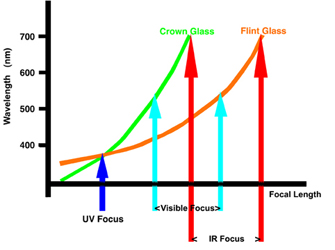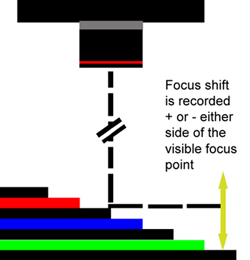Focus and Exposure
Correct and sharp focusing is vital to producing usable end results, as it is in all areas of photography. Infrared filtering can have a great effect on how a lens performs. The point of focus shifts quite significantly under infrared conditions. Simply closing down the aperture and hoping that depth of field will compensate is not the solution.
 |
The type of lens materials, coatings and construction will also influence the exact point of focus. These curves for crown and flint glass demonstrate that each glass focuses radiation of the same wavelength at different focal points. It also demonstrates that visible light is focussed at a different point from ultraviolet or infrared. |
Digital infrared has a huge advantage over film as the results can be checked nearly instantaneously.

With an infrared filter in place it is not possible to focus as all visible light is blocked. Focusing must be done without the filter in place. Great care needs to be taken when attaching and removing the filter so as to not disturb any camera settings, especially relevant when using 5x4 cameras.
 |
In a studio environment, focus compensation can be applied after running a few tests to determine the amount of focus shift required. A focusing block using a stepped wedge with increments of a known value can help provide the compensation value that needs to be applied. Focus correction can be applied in a number of ways depending upon the style of camera used. With 5 x 4 monorail or studio type cameras adjusting the lens or 'film' plane by the amount indicated by a focusing block / wedge helps maintain integrity of magnification ratios. Alternatively moving the object or camera in relation to one another. Focusing through a simple red filter can in some cases produce the required compensation. |
Exposure with infrared can be quite prolonged. Again the advantage with digital photography is that there is no wasted film and the results are almost instantly available.
As a starting point by choosing a high sensitivity rating speeds the process, reducing the time that delicate objects are exposed to heat and light.
When producing an image, using the highest bit depth and highest resolution helps reveal the greatest information. Imaging in full Colour Range (RGB) and not Grey Scale increases the scope for image enhancement at a later stage. With sensitivity in the three channels there can be variations in the amount of information captured in the red, green, and blue channels. By targeting specific channels faint detail can be enhanced. The results may not be pleasing to the eye, but the process is directed at gathering information. The final image can always be de-saturated to make it more aesthetically pleasing.
Ideal aperture and exposure is all subjective, with many variables involved including filter type, lighting and most importantly the object. However the stronger the filtering the longer the exposure: filtering at 750nm will require a shorter exposure than that of a 1000nm filter.